Text
Art in the Digital Age: Which way will it go?
In October 2020 I attended the Van Gogh Alive exhibit at the Birmingham Hippodrome. Far from any traditional exhibition I had visited before, Van Gogh Alive was a fully immersive installation of light and sound, inspired by his life. A “feast for all the senses” (Waywell, 2021), broken up, enlarged and “sometimes digitally animated” artworks by Van Gogh were projected across all walls and floors, as well as his own quotes and period photos of Paris (Frost, 2020). A soundtrack accompanied the projections, changing mood as the installation moved through different eras of Van Gogh’s life.
The experience had me wondering about what the future of art, exhibitions, and so on, would look like. Will art shift to be more digital than not? Will exhibitions be expected to become more immersive and innovative? These are genuine questions for those working in the cultural sector, especially as we move further into the digital age.

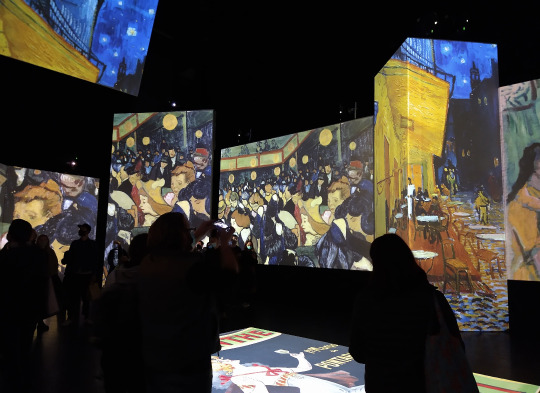
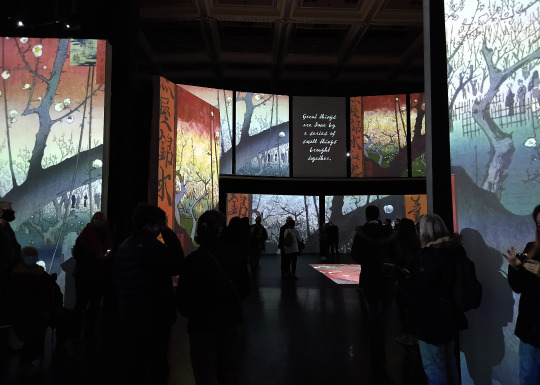
Images from Van Gogh Alive, taken by me.
In a recent episode of the BBC’s technology programme, Click, they explored what the future of art might look like. In the episode, presenter Spencer Kelly explores an artwork which has been created for virtual reality. After putting on the headset he is able to enter the black and white striped artwork as an avatar, made up of geometric shapes and also black and white. Walking around, he is also joined by other geometric-shaped avatars that have come to view, or experience, the artwork. What struck me was that this type of experience was simultaneously more interactive and more isolating than a traditional experience of art. You might be interacting with the art more directly this way, but you are also closing yourself off from others around you, or, with a VR set, you may not even be leaving your living room.

Everydays: The First 5000 Days by Beeple. Image: Christie’s Images Limited 2020. Available at: https://www.washingtonpost.com/entertainment/museums/beeple-digital-artwork-sale-perspective/2021/03/15/6afc1540-8369-11eb-81db-b02f0398f49a_story.html
However, I also wonder if, as art moves into the digital age, artists will actively resist such technical innovations. Recently, Everydays: The First 5000 Days, a digital artwork by Beeple (real name Mike Winkelmann), was sold at Christies for $69,000,000 after two weeks of bidding (Smee, 2021). Meanwhile, musician Grimes is said to have sold $6 million worth of digital art as NTFs, non-fungible tokens. To me, the fact that people will pay such high prices for something that can be seen by anyone goes to show the value of art as a commodity. For decades artists have resisted the commodification of their works; the entire conceptual art movement was born out of this aim (Smee, 2021). Therefore, I see it as quite possible that, as art seemingly becomes more of a commodity, artists will find new ways of creating art in order to resist such commodification, such as by resisting digital mediums and anything that will give their art any permanence.
Sources:
Frost, A. (2020) Van Gogh Alive review – resurrecting the dead in a glossy, impersonal blockbuster [Online] The Guardian. Available at: https://www.theguardian.com/artanddesign/2020/sep/23/van-gogh-alive-review-resurrecting-the-dead-in-a-glossy-impersonal-blockbuster (Accessed: 10th April 2021)
Kastrenakes, J. (2021) Grimes sold $6 million worth of digital art as NFTs [Online] The Verge. Available at: https://www.theverge.com/2021/3/1/22308075/grimes-nft-6-million-sales-nifty-gateway-warnymph (Accessed: 10th April 2021)
Smee, S. (2021) Beeple’s digital ‘artwork’ sold for more than any painting by Titian or Raphael. But as art, it’s a great big zero [Online] The Washington Post. Available at: https://www.washingtonpost.com/entertainment/museums/beeple-digital-artwork-sale-perspective/2021/03/15/6afc1540-8369-11eb-81db-b02f0398f49a_story.html (Accessed: 10th April 2021)
Waywell, C. (2021) There are TWO immersive Vincent Van Gogh shows on the way [Online] Time Out. Available at: https://www.timeout.com/london/news/there-are-two-immersive-vincent-van-gogh-shows-on-the-way-031621 (Accessed: 10th April 2021)
0 notes
Text
The Berlin Wall: Accidental Artwork?
The Berlin Wall was one of my earliest encounters with contemporary art, and one of the few that I actively sought out. I’d been fascinated with the Cold War since watching Deutschland ’83 and couldn’t wait to see history in real life. But when I did see it, I was struck by how mundane and incredibly normal it was, just a wall on a street in Germany. Some crowded around sections of the East Side Gallery taking pictures, while others walked past without a glance, on their way to work or to meet friends.
Until two months ago I hadn’t even considered the Berlin Wall to be art. However, since starting my course’s contemporary art module, I have been reflecting on and re-evaluating such experiences. In this post I want to explore the Berlin Wall, both as a piece of contemporary art, and for what it can teach us about contemporary art also.
The Berlin Wall was in no way built with the intention of being an artwork. Intended to keep East Germans from escaping to the West, it came to represent repression and division. However, from the 1980s, artists began to adorn the west side of the wall with graffiti, while still wary of the East German authorities patrolling the other side. It was an act of rebellion against the East German system and while much of the graffiti was simply scribbled writing, colourful murals began to appear, often characterised by symbolism that critiqued the wall and what it stood for (Grither, 2021). The two sides of the wall became totemic of the two systems of governance; one colourful, free and criticising; the other blank, grey, and voiceless.

My God, Help Me to Survive this Deadly Love by Dmitri Vrubel, 1990, East Side Gallery. The mural depicts Soviet President Leonid Brezhnev and East German President Erich Honecker. Image: The Collector. Available at: https://www.thecollector.com/art-on-the-berlin-wall/
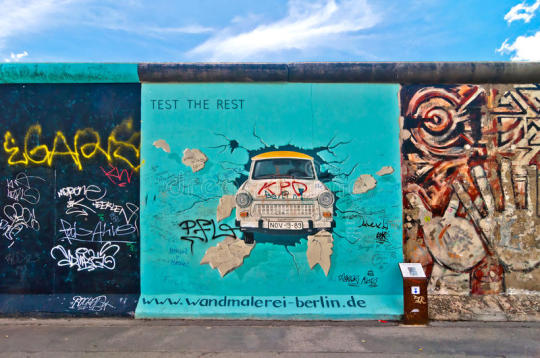
Test the Rest by Birgit Kinder, 2006, East Side Gallery. Mural shows a Trabant, a car symbolic of East Germany, breaking through the wall. Image: Jacob Kooistra. Available at: https://www.dreamstime.com/jacobkooistra_info
Upon reflection the Berlin Wall is undoubtedly a work of contemporary art. It has created entire careers, namely that of artist Thierry Noir who is often titled The Pioneer of Berlin Wall Art, with his brightly coloured, cartoon-like figures now iconic (Grither, 2021). Berlin Wall art has been given recognition by world famous artists, such as Keith Haring who was invited to paint the wall in 1986. Unfortunately, his mural was painted over just days after completion (Grither, 2021). Additionally, the wall’s art went on to inspire a wave of street art in Berlin, and vast murals can be spotted across the city today.

Thierry Noir’s iconic style. Image: Thierry Noir. Available at: https://thierrynoir.com/essays/berlin-wall/

Noir on the East side of the wall after it fell. Image: The Guardian. Available at: https://www.theguardian.com/artanddesign/jonathanjonesblog/2014/apr/03/thierry-noir-graffiti-artist-berlin-wall

Keith Haring decorates the Berlin Wall. Image: Photo by Tseng Kwong Chi, 1986. Copyright Muna Tseng Dance Projects Inc. Available at: https://espionart.com/2013/08/16/haring-paints-the-berlin-wall/
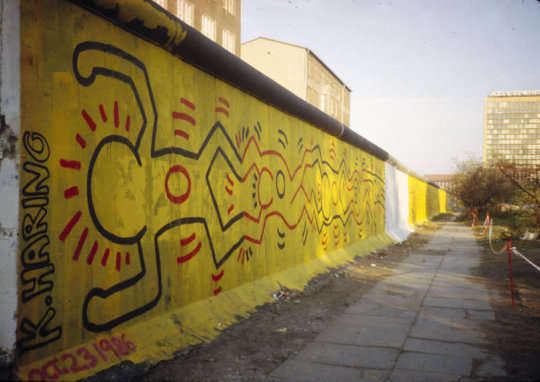
Detail of Haring’s mural, painted in the colours of the German flag. Image: Keith Haring Foundation. Available at: https://www.haring.com/!/archives/murals-map/attachment/berlin-wall-03
The Berlin Wall has even become a commodity, as well as a symbol, with entire sections of it having been sold off and now being displayed in locations of high esteem (Grither, 2021). Such locations include the garden of the United Nations’ headquarters in New York, and the European Commission’s headquarters in Brussels. Finally, over the years the Berlin Wall has even developed a conceptual element, something often associated with contemporary art. It not only stands as a symbol of history, politics and repression, but as a symbol of the “walls in the mind… the barriers that prevent us from communicating, understanding each other, and making progress” (Hickley, 2019).

Section of the Berlin Wall in United Nations Sculpture Garden. Image: Michelle Young, Untapped New York. Available at: https://untappedcities.com/2019/07/17/the-pieces-of-the-berlin-wall-in-the-united-nations-sculpture-garden/
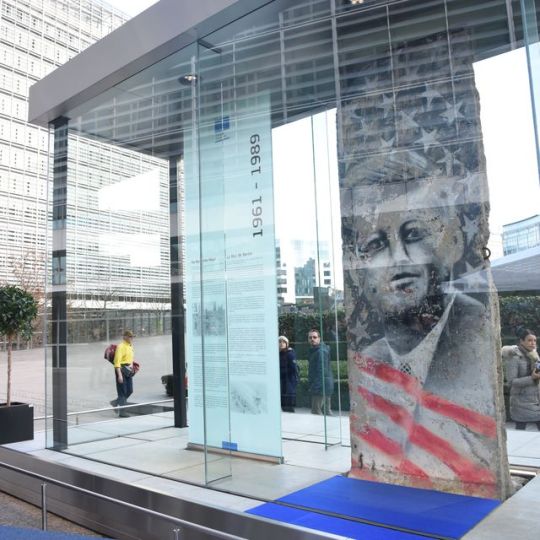
The Kennedy Piece, next to the headquarters of the European Commission in Brussels. Image: Visit Brussels. Available at: https://visit.brussels/en/place/Kennedy-Piece-the-Berlin-Wall

Another section of the Berlin Wall in New York. Image: Nicole Cohen. Available at: http://sketch42blog.com/2012/04/art-on-the-street/
Following the fall of the wall in 1989, it was agreed that a section of the wall on the East Berlin side, in Mühlenstrasse, would be designated for art. In a poetic turn of events, this area, named the East Side Gallery, has now become the most prominent exhibition of the Berlin Wall today (Grither, 2021). For me, this is symbolic of the political and cultural change that was to take place in East Berlin.
Exploring the Berlin Wall through the lens of contemporary art has allowed me to explore contemporary art itself in more depth, enabling me to learn a few things. Firstly, just because something does not begin as art or does not intend to be art, does not mean that it isn’t. Secondly, I have realised how important politics is as an influence on art, particularly in recent years, whether it be political elections, actions of the authorities, or entire regimes. Finally, the most significant thing I have discovered so far on my journey to understanding contemporary art better is the importance of freedom. Through my research I have come to view freedom as a defining factor in contemporary art, from freedom of opinion to freedom of chosen medium, or the freedom to be deeply conceptual to purely aesthetic. No other genre encapsulates freedom in the way contemporary art does.

Fall of the Berlin Wall 1989. Image: Andree Kaiser/ Alamy. Available at: https://www.theguardian.com/world/2019/nov/03/berlin-wall-30-years-on-five-german-writers-assess-bernhard-schlink-franck-geissler-ohler
Sources:
Grither, D. (2021) The Art on the Berlin Wall: Sentiments of East and West Berlin [Online] The Collector. Available at: https://www.thecollector.com/art-on-the-berlin-wall/ (Accessed: 5th April 2021)
Hickley, C. (2019) 30 Years since the Berlin Wall Fell, Artists Reflect on the Barriers That Remain [Online] Artsy. Available at: https://www.artsy.net/article/artsy-editorial-30-years-berlin-wall-fell-artists-reflect-barriers-remain (Accessed: 5th April 2021)
Noir, T. (2020) The Berlin Wall [Online] Thierry Noir. Available at: https://thierrynoir.com/essays/berlin-wall/ (Accessed: 6th April 2021)
0 notes
Text
Eve Provost Chartrand: New Life
Please note that quotations are taken from an artist’s statement given to students by Chartrand for the lecture.
In February I attended a lecture by mixed-media artist Eve Provost Chartrand. In both concept and aesthetic, her art was like none other that I have encountered before. Initially unsure how I felt or even what I thought about Chartrand’s work, over the following weeks it grew on me and opened my mind to new ideas. Through her “performative assemblages and installations” the new ideas I was exposed to surrounded concepts in regards to death and ageing. Over the past few years I have become increasingly avoidant of this topic, as I see more and more how it affects those close to me; my parents, grandparents, and family friends. However, because of Chartrand I was forced to reflect on it.
Through her art, Chartrand hopes to celebrate “all bodies”, focussing on women’s ageing bodies in particular. She describes such “disgraceful” bodies as often triggering “unease, contempt, and/ or indifference”, compelling her to find ways to “resist and transgress such discriminative gazes”. Challenging these long standing views, after Chartrand’s lecture I found myself starting to look at ageing in a less intimidating light. In this sense she achieved her goal of “generating re-interpretations and re-considerations of ageing “negative” bodies”.
I was fascinated by the innovative media used by Chartrand, which included mould, hair, mushrooms and an array of found objects. I feel her chosen media and the objects she makes her assemblages up of are essential to “evoking horror and fragility” while speaking of “regeneration, solidarities and shared vulnerabilities”.
There was one artwork in particular that stood out to me. Part of Chartrand’s series Is There Anybody Home?, Specimen #2: Dentures consists of two separate pieces. One is a sculpture that to me looks somewhat like a headless fish, with the rim decorated using the teeth of her mother’s dentures. The second piece is a Petri dish containing a bacterial colony, grown from the bacteria swiped from aforementioned dentures. Both of these pieces give a new perspective on life and death. In one the items of the deceased have been repurposed and given a new life, helping the deceased individual to in some way live on. Meanwhile the other shows how from our own life other unique life forms are created, allowing us to still be part of and impact the world even after death.

Is There Anybody Home? Specimen #2: Dentures. Image: Eve Provost Chartrand
Chartrand’s concepts give light to new interpretations about life and death, and I believe they are a great starting point, with the ability to open people up to the conversation about how they view ageing and perhaps how those views should be re-evaluated.
Eve Provost Chartrand’s website: https://www.eveprovostchartrand.com/
Here you can find another version of her artist’s statement: https://www.eveprovostchartrand.com/copy-of-about-me
0 notes
Text
Gent 48: Brightening up Birmingham
I first discovered the work of Gent 48 as I was walking to Birmingham’s China Town, surprised to see the usually desolate car park behind the Asian food court suddenly ornate with an array of bright colours. Unbeknown to me, Gent 48, a graffiti artist and illustrator from Birmingham, had been creating artworks around the city for a number of years. He is now largely known for his character-based murals, originally inspired by the facial features of comic book characters, and has been commissioned for works across the globe.

Chinatown mural

Chinatown mural
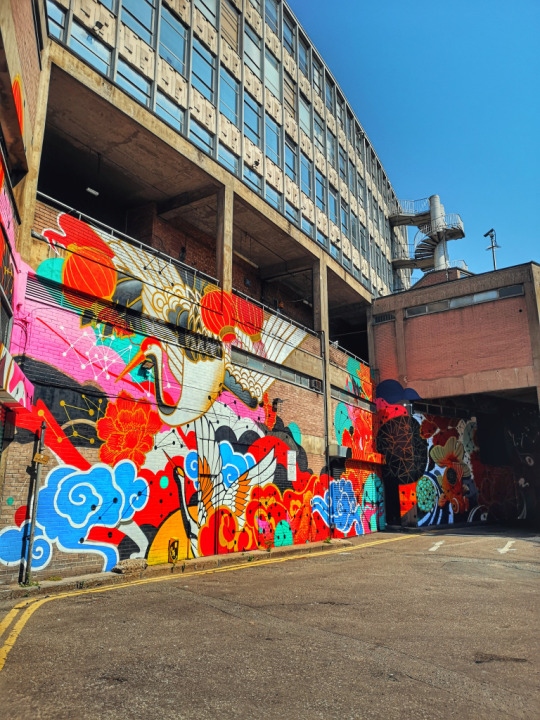
Chinatown mural. Image: Bab About Town, 2020 https://bababouttown.com/2020/11/30/photography-in-brum-my-favourite-spots-part-two/
Many of the places in Birmingham that Gent 48 has produced his artworks are arguably run down or they are at least certainly not lively areas; boarded up buildings and unused car parks of industrial areas no longer in their prime; streets of shop rows where many of the shops have been empty for some time. But I admired the attempt and care to brighten up such places and try to inject more life into them, even when business wasn’t looking hopeful. Since the start of a series of lockdowns in 2020, in which many businesses have been closed, this feeling has only amplified.
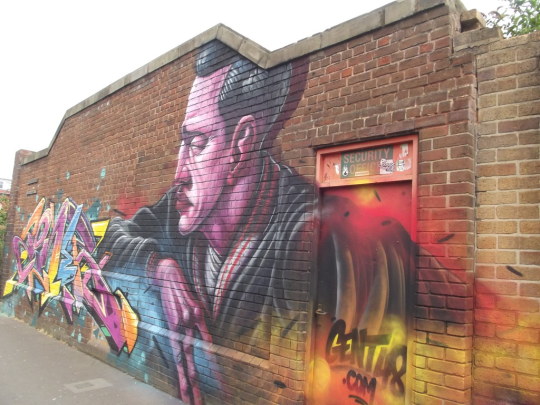
Bradford Street, Digbeth. Image: Elliot Brown, 2014 https://www.flickr.com/photos/ell-r-brown/13978320353

Southside Street, Smallbrook Queensway. Image: Elliot Brown, 2020 https://www.flickr.com/photos/ell-r-brown/50222144268
In my own hometown many businesses have closed down over the past few years, and unfortunately many more will not reopen once lockdown is lifted, with lockdown restrictions being the final nail in the coffin. This is a story echoed across the country, including in Birmingham. Because of this, my perspective on Gent 48’s graffiti art has somewhat shifted recently, from simply an aesthetic way to brighten up the area, to a symbol of hope. Through his murals he is able to bring colour and life into the world of the unknowing passer by, even in times like these.

Mural depicting key workers. Image: Style Birmingham, 2020 https://stylebham.com/when-art-and-charity-collide/
What struck me as particularly significant when reflecting on Gent 48’s graffiti art was the community aspect of his medium. His murals cannot be easily stolen, bought or gifted, to be stashed away in some private collection. They cannot be displayed in a museum or gallery. Instead, they are out in the open for anyone to see and access, which is important following a year of a seemingly increasing gap between rich and poor. This caused me to reflect wider, realising that this runs true for much of contemporary art. Artists are increasingly creating works that are displayed out in the open, at the mercy of the elements, works that are site specific and therefore difficult to hold in a private collection, works that are easily perishable and ever changing. In which case, it will be very interesting to see where contemporary art takes us in the future, and how the role of art may change.

Southside district in Birmingham. Image: Gent 48 on Facebook, 2021 https://www.facebook.com/GENT48/photos/pb.420667951351275.-2207520000../3816552718429431/?type=3&theater

Artists Gent 48 and Newso create a mural for The Body Shop. Image: Birmingham Live, 2016 https://www.birminghammail.co.uk/whats-on/arts-culture-news/city-graffiti-artists-newso-gent-10893692
Sources:
Art4Charity (2020) Gent 48 [Online] Available at: https://art4charity.co.uk/gent-48/ (Accessed: 30th March 2021)
Miles, J. (2016) Gent48 [Online] Bab Mag. Available at: https://babmag.co.uk/gent-48/ (Accessed: 30th March 2021)
Young, G. (2016) City graffiti artists Newso and Gent 48 transform another wall in Digbeth [Online] Birmingham Live. Available at: https://www.birminghammail.co.uk/whats-on/arts-culture-news/city-graffiti-artists-newso-gent-10893692 (Accessed: 30th March 2021)
0 notes
Text
Stanley Chow: Impact of the Contemporary World on Contemporary Art

Photo of artist Stanley Chow. Image: Manchester Evening News (2018) https://www.manchestereveningnews.co.uk/business/business-news/how-2am-phone-call-white-14298296
As part of this blog my aim is to delve into what exactly contemporary art means. Today I will be exploring this idea through the work of British Chinese artist Stanley Chow, and particularly how the contemporary world has impacted his work.
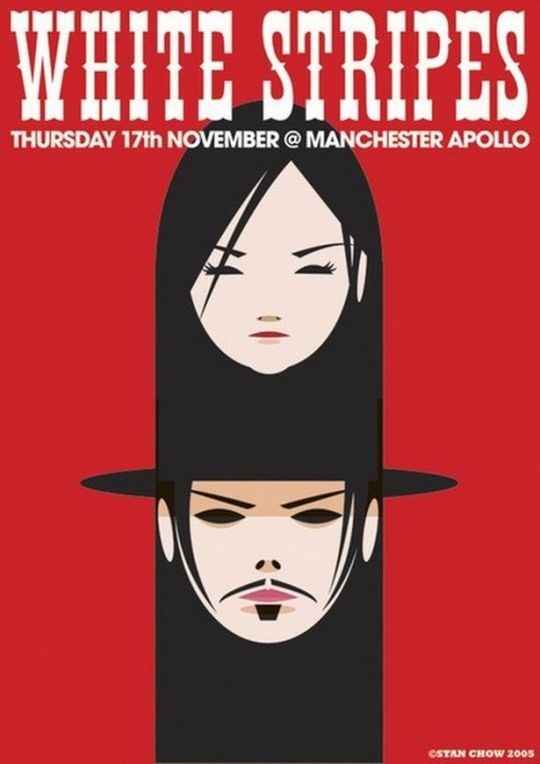
Mock White Stripes concert poster by Chow. Image: Manchester Evening News (2018) https://www.manchestereveningnews.co.uk/business/business-news/how-2am-phone-call-white-14298296
Contemporary art and design software was paramount to the development of Chow’s style: flat colour, geometric shapes, and an overall more simplistic design, resulting in an aesthetic instantly recognisable as his (Sherbert Lemon UK, 2018). It was through the social media of the contemporary world that he was given a huge career boost; after Chow posted a mock concert poster he had designed of the White Stripes, their management called up asking to work with him.

Portrait of Edgar Davids. Image: Pinterest https://co.pinterest.com/pin/376402481327459460/
It was also through social media that he began to gain a celebrity following; when Chow uploaded a portrait of Wayne Rooney, Edgar Davids saw and asked for one of him (Sherbert Lemon UK, 2018)!
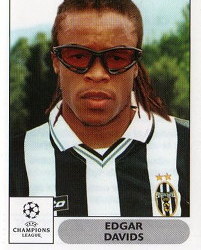
Edgar Davids football card. Image: Rock Paper Shotgun https://www.rockpapershotgun.com/edgar-davids-wins-league-of-legends-skin-court-case
Social media has even influenced the design of some of his work, namely the InStanGram collection for the CFCCA in Manchester, in which he explored his British-Chinese identity through illustrations imitating Instagram posts.

Illustration from InStanGram collection. Image: Golden Pin https://www.goldenpin.org.tw/en/perspectives_stanley-chow/
Additionally, the contemporary forms of communication and advances in technology that have developed over the past few decades have allowed Chow to reach and receive work worldwide, all from his hometown of Manchester, something that would have been much more difficult a few decades ago. He has since worked within music, fashion, computer games, children’s books, magazines and advertising (Collier, 2014). It is also interesting to see that, despite the role of the contemporary world on Chow’s work, he is most known for the traditional genre of portraits.
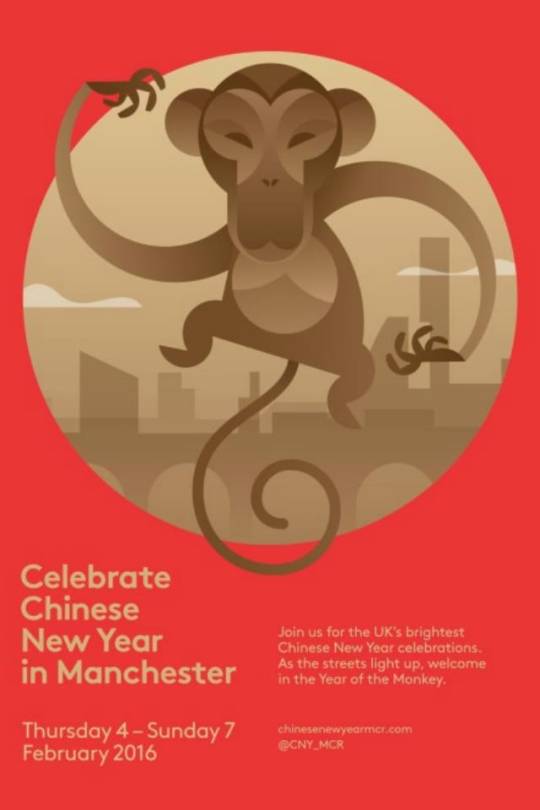
Advertisement for Chinese New Year celebrations in Manchester, designed by Chow. Image: Golden Pin https://www.goldenpin.org.tw/en/perspectives_stanley-chow/
What constantly came to mind as I was exploring Chow’s work was the idea of identity. For Chow, this covered his strong connection with being a Northerner, his love of football as a Man United fan, and his Chinese roots (BBC Sport, 2018). The genre of portraits itself has close links to the idea of identity, and the vast range of characters Chow illustrates allows others to identify themselves within his work, too. People depicted by Chow range between music icons, footballers, actors, political figures and beyond, all of which touch on aspects that many feel are important to their identity.

Illustration of Manchester band The Stone Roses. Image: Manchester Evening News (2018) https://www.manchestereveningnews.co.uk/whats-on/arts-culture-news/manchester-illustrator-stanley-chow-16342253
Exploring Chow’s work, I began to see the importance of identity within contemporary art. The vast majority of contemporary art I have encountered has in some way been linked to aspects of one’s identity, perhaps their views on the world or their inner emotions. The second point it raised was the debate between concept and technique. According to Chow, the art courses he did cared more about concept than actual technique (Sherbert Lemon UK, 2018). Often when people think of contemporary art they assume it is conceptual. In a lecture for my contemporary art module at university, many people said they initially dismissed contemporary art because they did not understand it. Yet, Chow’s work is easy to understand, purely visual. For Chow, developing his technique is essential to his chosen medium.

China Town illustration. Image: Manchester Evening News. (2018) https://www.manchestereveningnews.co.uk/whats-on/arts-culture-news/manchester-illustrator-stanley-chow-16342253
Stanley Chow has become incredibly popular, working with such brands as Lego, Wired, McDonald’s and WWE (Collier, 2014), as well as selling non commissioned works on his online shop. I believe there are a few reasons for this popularity. Firstly, is the fact that so many people are able to identify with his work due to the subjects he portrays. It allows them to immediately feel connected. Even the style of his portraits is inspired by Panini football cards, which are recognised by millions across the country (BBC Sport, 2018). Owing to the clean, minimalist style and lack of conceptual element, Chow’s works are easily understood and therefore accessible to a much wider range of people than many other works of contemporary art might be. And finally, Chow’s subjects are often currently relevant in pop culture, whether related to recently occurring events, such as an election, or depicting a musical artist from the 1970s who is still an icon today.

Stanley Chow self portrait. Image: Manchester Evening News (2019) https://www.manchestereveningnews.co.uk/whats-on/arts-culture-news/manchester-illustrator-stanley-chow-16342253
Sources:
BBC Sport (2018) Stanley Chow: Football illustrator who has with Edgar Davids Sir Alex Ferguson as fans - BBC Sport [Online] Available at: https://www.youtube.com/watch?v=Hv00Y55MPNc (Accessed: 15th March 2021)
Collier, M. (2014) Interview: Stanley Chow [Online] Inkygoodness. Available at: http://inkygoodness.com/features/interview-stanley-chow/ (Accessed: 16th March 2021)
Sherbert Lemon UK (2018) Let’s Talk Creative - S1 E2 Stanley Chow [Online] Available at: https://www.youtube.com/watch?v=mEqFbBTT2Zg (Accessed: 14th March 2021)
0 notes
Text
Rachel MacLean: Modern Day Master
,‘Sickly sweet’ and ‘coloured with an absurdist comedy’ (Brown, 2018). ‘Tacky, kitsch and utterly repellent’ (Saunders, 2018). ‘A constant back and forth between the seductive and the unsettling’ (Couston, 2016). These are just a few ways the saccharine colour schemed work of artist Rachel MacLean has been described.
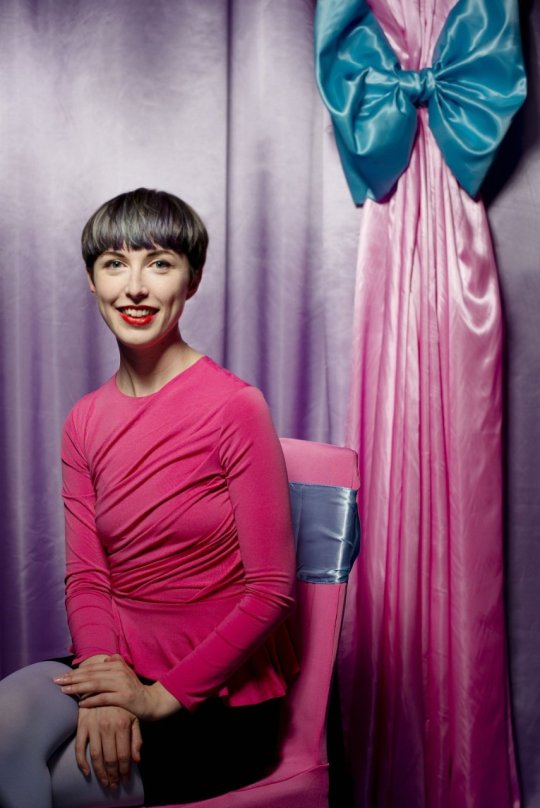
Rachel MacLean. Image: David Bebber, 2019
Possibly the most pertinent contemporary artist of our time, MacLean’s works are predominantly digital videos (Couston, 2016). Born in 1987, Maclean has gained attention in recent years, even going on to represent Scotland at the 2017 Venice Biennale (Saunders, 2018).
I first discovered the work of Rachel MacLean when she curated Too Cute (2019) at Birmingham Museum and Art Gallery. The exhibition, alongside an explanation video by “Dr Cute”, played by MacLean, drew me in, in a way no exhibition had before.
For Too Cute, MacLean had juxtaposed ‘contemporary objects and art with those from the Nineteenth Century’ (King, 2019). The questions the exhibition aimed to raise were one factor that intrigued me. Have people always had a compulsion to all things cute and lovely? Has the idea of cuteness changed over the generations? At what point does cute cross the line into scary and repelling?
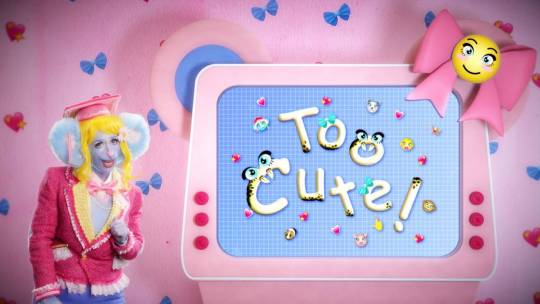
Still from Dr Cute video. Image: Art Fund, 2019 https://www.artfund.org/whats-on/exhibitions/2019/01/26/too-cute-exhibition
The other factor was the way these questions were presented to the viewer. While Dr Cute’s video touched on serious themes such as escapism from our daily lives and the excesses of consumerism, it was almost masked by the candy colours, exaggeration, reference to pop culture and satirical element. ‘Cuteness is a huge part of contemporary life: advertising, filters, emojis, memes, fashion’ and so on (King, 2019). Therefore, while MacLean’s art seemed absurd, it was, as with much of her work, ‘at once entrancingly strange and disturbingly familiar’ (Langley, 2016).
So, what exactly does Rachel MacLean do? Within her videos the artist uses green screen technology to display digitally created imagined backgrounds (Couston, 2016). Alongside digital editing, MacLean’s aesthetic is marked by a continuous reference to pop culture and mass media tropes. For example, Feed Me (2015) includes ‘X-factor style auditions, skin cream ads, Disney style sing-alongs and a soap opera’ (Couston, 2016). However, MacLean takes the merging of the real and the imagined one step further; her films are ‘collaged from found objects’ (Langley, 2016) and often contain found audio sources, ranging from Britain’s Got Talent to David Cameron’s speeches (Couston, 2016).

Still from Feed Me. Image: Frieze, 2016 https://www.frieze.com/article/focus-rachel-maclean
MacLean’s characters are distinct art works in their own right. Her characters, ‘taken from Disney animations and fairytales or inspired by commercial advertising,’ (Couston, 2016) are made up of found objects such as wigs, masks, and ‘elaborate candy-coloured costumes’ (Brooks, 2018). With MacLean a fan of caricature (Saunders, 2018), it is no surprise that her characters possess jarring features, whether accentuated teeth or melting skin. As MacLean explains in an interview, “there’s a strange power in the grotesque,” it can be easily and purposefully achieved, as opposed to today’s beauty standards that aim to keep you buying (Brooks, 2018).
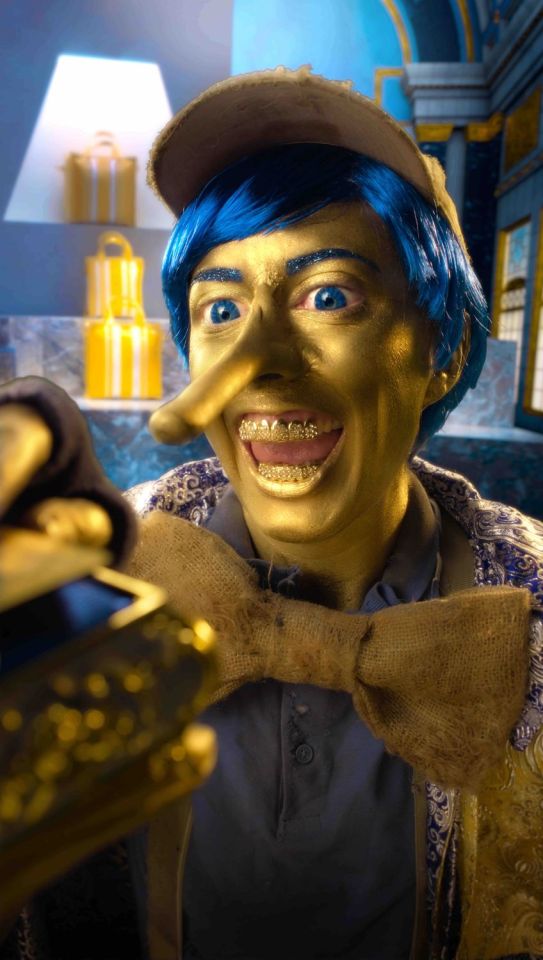
Still from Spite Your Face. Image: ArtRabbit, 2018 https://www.artrabbit.com/events/rachel-maclean-spite-your-face-chapter
Among her influences MacLean counts Cindy Sherman particularly her portraits; “it feels very relevant now to the age of social media… people representing themselves in photographs as their idealised self” (Brown, 2018). Additionally, she is inspired by video artists Shana Moulton and Ryan Trecartin (Langley, 2016). Comedy has impacted MacLean’s work, evident by the satirical nature of her films; “you can talk about serious ideas without it feeling too weighty… laughing at systems of power is quite a powerful thing” (Brown, 2018). However, perhaps somewhat unexpected at first glance, MacLean’s work is steeped in Art History. A fan of Bosch’s Renaissance triptychs and Hogarth’s eighteenth-century cartoons (Saunders, 2018), the influence of the past on MacLean’s work can be seen in Spite Your Face (2017) with Piero della Francesca’s one point perspective, and the ‘crowded, flattened world of a Giotto fresco’ (Brown, 2018), and in Make Me Up (2018) in which MacLean challenges ‘the male oriented art canon’ (Brown, 2018).

Still from Make Me Up. Image: Rachel MacLean, 2018 http://www.rachelmaclean.com/make-me-up-film/
MacLean’s works encapsulate a range of themes and ideas paramount in today’s society. She ‘presents a critical and satirical view of the excesses of consumerism,’ even touching on the commercialisation of happiness and wellbeing (Couston, 2016). During filming for Channel 4’s Artist in Residence series, MacLean was able to delve deeper into this, after living inside Birmingham’s Bull Ring shopping centre. Of consumerism, she stated, “it’s an entire culture that necessitates dissatisfaction,” and thus was born a new character; the Satisfaction Bunny (Brooks, 2018). MacLean also discussed the hidden level of censorship in what are seemingly public spaces, after not being able to film in shops or interview staff; “the only way was to make art about the level of censorship around these brands” (Brooks, 2018).

MacLean outside the Bullring as the Satisfaction Bunny. Image: The Guardian, 2018 https://www.theguardian.com/artanddesign/2018/aug/05/rachel-maclean-artists-in-residence-channel-4-birmingham-bullring
MacLean has touched on various types of identity within her work; The Lion and The Unicorn (2012) and A Whole New World (2014) engages with Britain’s national identity and colonial past while Feed Me explores the class divide (Langley, 2016). Make Me Up, on the other hand, explores women’s suffrage and male fear at female empowerment (Saunders, 2018). The recurring presence of technology and reliance on smart phones is another identifier of MacLean’s work, with the ‘unnervingly cutesy aesthetic’ (Langley, 2016) being compared to that of social media filters (Brown, 2018). Throughout all of this, characters within the films speak directly to the camera; MacLean is confronting us, urging the audience to directly engage with issues presented to them (Langley, 2016).

Still from A Whole New World. Image: BBC, 2013 https://www.bbc.co.uk/programmes/p052dh8s
Rachel MacLean isn’t the first or only artist to analyse these themes. However, the aesthetic she uses and the continuous references to the modern day make her works difficult to ignore, and her ideas more easily accessible and understood. This is furthered by the range of influences she draws on, ‘from Baroque architecture to Korean pop videos’ (Saunders, 2018). I am fascinated with how MacLean is able to reflect modern society in her works, using satire to get us to subconsciously question it ourselves. As Frieze sums it up, MacLean ‘exaggerates pop culture in order to reveal its underlying absurdities, heightening our awareness of reality rather than providing fanciful distraction from it’ (Langley, 2016).
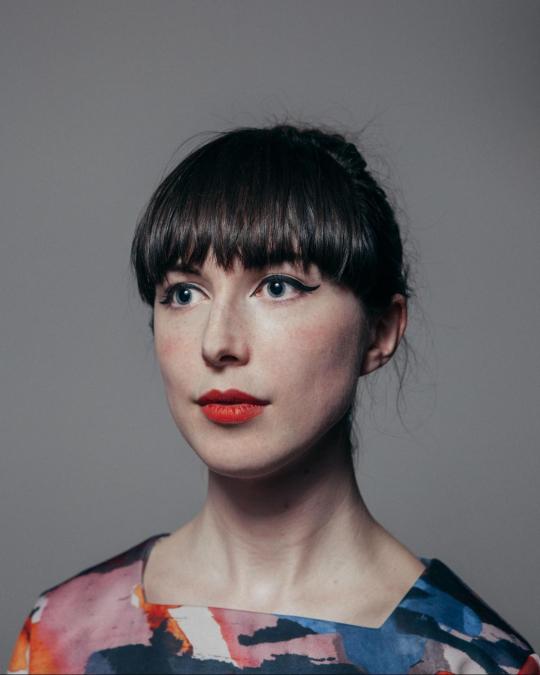
Rachel MacLean. Image: The Herald Scotland, 2016 https://www.heraldscotland.com/news/14481256.meet-rachel-maclean-candy-coloured-nightmare-world-artist-represent-scotland-venice-20
Sources:
Brooks, L. (2018) Rachel MacLean: My month in hell as the Bullring bunny [Online] Guardian. Available at: https://www.theguardian.com/artanddesign/2018/aug/05/rachel-maclean-artists-in-residence-channel-4-birmingham-bullring (Accessed: 5th March 2021)
Brown, G. M. (2018) Rachel MacLean: Satire for the Age of Snapchat [Online] Financial Times. Available at: https://www.ft.com/content/a6cb6d0a-bfee-11e8-95b1-d36dfef1b89a (Accessed: 7th March 2021)
Couston, E. (2016) Five Minutes on Rachel Maclean [Online] Tate. Available at: https://www.tate.org.uk/context-comment/articles/rachel-maclean-art-now (Accessed: 7th March 2021)
King, J. (2019) Too Cute! What happens when sweet gets sinister? [Online] Art UK. Available at: https://artuk.org/discover/stories/too-cute-what-happens-when-sweet-gets-sinister (Accessed: 5th March 2021)
Langley, P. (2016) In Focus: Rachel MacLean [Online] Frieze. Available at: https://www.frieze.com/article/focus-rachel-maclean (Accessed: 5th March 2021)
Saunders, T. F. (2018) Rachel MacLean interview: ‘There’s a fear that if women makes jokes they’re going to start laughing at men’ [Online] The Telegraph. Available at: https://www.telegraph.co.uk/art/artists/rachel-maclean-interview-fear-women-make-jokes-going-start-laughing/ (Accessed: 7th March 2021)
2 notes
·
View notes